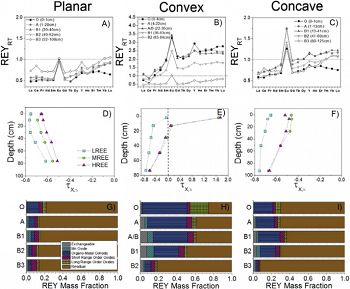Vázquez-Ortega et al., 2016
Solid-phase redistribution of rare earth elements in hillslope pedons subjected to different hydrologic fluxes
Vázquez-Ortega A., Huckle D., Perdrial J., Amistadi M.K., Durcik M., Rasmussen C., McIntosh J., Chorover J. (2016)
Chemical Geology 426: 1-18
-
Catalina-Jemez, GRAD STUDENT
-
Catalina-Jemez, GRAD STUDENT
-
Catalina-Jemez, Luquillo, Reynolds, INVESTIGATOR
-
Catalina-Jemez, STAFF
-
Catalina-Jemez, INVESTIGATOR
-
Catalina-Jemez, INVESTIGATOR
-
Catalina-Jemez, INVESTIGATOR
Plain English Summary
- Rare earth element distribution patterns in soil weathering profiles reflect the combined effects of hydrologic fluid flow and biogeochemical weathering processes.
- REE patterns are consistent across multiple samples for a given selective chemical extraction step.
- Soil organic matter complexes are enriched in middle REE constituents.
- Cerium anomalies reflect redox dynamics in soil profiles and are coupled to iron (oxyhydr)oxide formation.
Abstract
REY fractionation patterns for the total solid phase (top), REY chemical depletion/enrichment patterns (i.e., tau plots, middle) and extractability patterns (bottom) as a function of depth in planar (left), convex (center) and concave (right) hillslope profiles. REY values for top row figures were normalized to the ZOB weighted average (RT) bedrock composition, whereas the middle row figures were based on bedrock (RT) normalized REE/Ti concentration ratios. Mass fractions are labeled with the names of the target phases, and are associated with the following chemical extractions: 1.0 M CH3COONa (pH 5.5), 0.1M NH2OH ∙ HCl (pH 2), 0.1 M Na4P2O7 (pH 10), 0.25 M NH2OH ∙ HCl (pH 1.5), and 1.0 M NH2O HCl (pH 1). LREE, MREE, and HREE represent light, medium, and heavy rare earth elements, respectively. LREE = La to Nd, MREE = Sm to Tb, HREE = Dy to Lu (Y not included).
Prior studies indicate that patterns of rare earth element (REE) depletion or enrichment in critical zone (CZ) weathering systems are sensitive to variation not only in lithology, but also in climatic and/or biological processes. Organic ligands and secondary mineral surfaces vary in complex stability with different lanthanide series metals, which can result in solid-solution fractionation during incongruent mineral dissolution. REE fractionation during precipitation of solid phase weathering products is also expected to vary with host phase affinity and aqueous geochemistry along fluid flow paths. We postulated that patterns of REE fractionation during pedogenic weathering would exhibit mass-dependent trends as a function of depth in the soil profile. We further hypothesized that REE signatures would be influenced by depth-dependent variation in water and dissolved organic carbon (DOC) fluxes resulting from topographic position of the pedon under investigation. Field-based hypothesis testing utilized instrumented pedons derived from rhyolitic bedrock overlain by mixed conifer forest in the Jemez River Basin Critical Zone Observatory (JRB-CZO). REE depletion trends correlated with topographically-induced variation in soil pore water and DOC through-fluxes occurring predominantly during winter snowmelt. Bulk regolith analyses indicated that light rare earth elements (LREE) were depleted preferentially relative to medium and heavy REE (MREE and HREE). Lateral fluxes of water and DOC through subsurface horizons in the concave hillslope pedon correlated not only with greater REE depletion, but also with greater fractionation of REE into organo-metal colloid forms (2-23%) relative to a planar site hillslope pedon (3-13%) where vertical water and DOC fluxes were predominant. MREEs were preferentially retained in secondary colloids, indicating a mechanism for their stabilization in the weathering profile. Positive Ce-anomalies in the soils were the result of Ce retention in pedogenic Fe-(oxy)hydroxides.
Citation
Vázquez-Ortega A., Huckle D., Perdrial J., Amistadi M.K., Durcik M., Rasmussen C., McIntosh J., Chorover J. (2016): Solid-phase redistribution of rare earth elements in hillslope pedons subjected to different hydrologic fluxes. Chemical Geology 426: 1-18. DOI: 10.1016/j.chemgeo.2016.01.001
 This Paper/Book acknowledges NSF CZO grant support.
This Paper/Book acknowledges NSF CZO grant support.
Associated Data
Jemez 2013 Burned ZOB - Soil Geochemistry (2010)
1 components •
Jemez 2013 Burned ZOB •
Geochemistry / Mineralogy, Soil Science / Pedology, Geomorphology •
Craig Rasmussen; Jon Chorover
Explore Further








